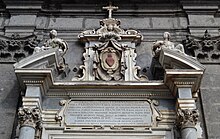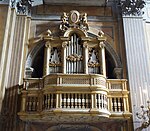San Ferdinando (Church, Naples)
| Chiesa di San Ferdinando | |
|---|---|
| Patronage : | Saint Ferdinand III. of Castile |
| Order : | Jesuit |
| Address: | Piazza Trieste e Trento, Naples |
Coordinates: 40 ° 30 '5.6 " N , 14 ° 8' 44" O Church San Ferdinando from Naples is located in the historic center on Piazza Trento Trieste e, next to the Galleria Umberto I , in the vicinity of the Teatro San Carlo and the Palazzo Reale .
history
The church was built by the Jesuits and was originally intended as a place of worship for Saint Francis Xavier , who was canonized in 1622. At first there was a lack of funds until Catalina Zunica de la Cerda y Sandoval, the wife of the Spanish viceroy Conte di Lemos, donated 39,000 gold scudi to the order .

The Jesuit Father Agatio Stoia was initially in charge of the construction work. However, his plans were first revised by Giovan Giacomo di Conforto , and finally the project was handed over to Cosimo Fanzago , who, although taking into account the ideas of his two predecessors, is considered the real creator of the church.
The foundation stone was laid on February 2, 1636. A first part of the church was consecrated as early as 1641 , but the construction work was not completed until 1655 and the interior decorations, in which the fresco artist Paolo De Matteis and the sculptor Domenico Antonio Vaccaro took part for a few more decades. The upper part of the facade was renewed between 1738 and 1759.
When the Jesuits were expelled from Naples in 1767, the church came into the hands of the Cavalieri Costantiniani until the beginning of the French occupation in 1801 . During this time the church was given to Saint Ferdinand III. consecrated by Castile. From 1827 the building was under the control of the Arciconfraternita di Nostra Signora dei Sette Dolori , whose coat of arms can still be seen above the entrance portal. A restoration took place under King Ferdinand II in 1853.
San Ferdinando is known as the "Church of the nobles and kings" and was particularly valued by the Bourbon royal family . It is also known as the “Church of Artists” ( Chiesa degli artisti ) because it celebrated the funerals of many famous people (actors, singers) from Naples, including Achille Lauro , Sergio Bruni , Roberto Murolo and Mario Merola . Since December 2017, the church has also housed a nativity scene, where the shepherds are represented by figures by well-known Neapolitan artists; the crib is a joint work of artisans from the Associazione Theotokos .
Traditionally, in San Ferdinando, mass is celebrated in Latin according to the old rite every Sunday at 6:00 p.m.
description
plan
|
Exterior
The lower part of the facade corresponds to the designs by Cosimo Fanzago from the 17th century. The white marble of the elegantly ornamented frames of the portal and niches stand out from the pilaster- structured wall surface made of dark piperno .
The upper part of the facade dates from 1738 to 1759, but was changed again at the end of the 19th century during the so-called Risanamento of Naples. The curved volutes and balustrades on the sides were removed in favor of a classicist triangular tympanum , as it was originally intended by Giovan Giacomo di Conforto.
The Baroque plans also included a cast iron grille, which was likely designed by Francesco Antonio Picchiatti . However, it was also removed during the Risanamento , presumably because it had been damaged by the construction work on the Galleria Umberto I.
The inner
Church interior and dome
The interior has the shape of a Latin cross with four side chapels on the right and left and a crossing dome over the transept . The main colors of the marble wall decorations are golden yellow, pink (red) and white, contrasted with beige and a little black. The white composite - capitals over pink-white-black-striped pilasters are unusually plastically shaped and particularly baroque effect.
Right next to the entrance are two marble holy water stoups by Cosimo Fanzago. Filippo Pardo created the floor in 1748. At the end of the nave, above the arches of the last two chapels, there are two galleries with the organs . The pulpit on the last pillar on the left dates from the 19th century.

A large part of the church was painted with frescoes by Paolo De Matteis : on the entrance wall next to the large window he depicted Saint Francis Xavier in ecstasy , and on the other side Francis Xavier hugging the crucifix . The large ceiling fresco was created by De Matteis between 1695 and 1698, it shows the triumph of religion over heresy with the Saints Ignatius of Loyola, Francis Xavier, Francesco de Borgia and three Japanese martyrs (below left you can see Mohammed with the Koran ). The rest of the decoration on the ceiling was made by Gennaro Greco at the end of the 17th century.
The dome was also originally painted by Paolo De Matteis with a Transfiguration of the Jesuits , but these frescoes were destroyed during the construction of the Galleria Umberto I and replaced by some allegorical figures and angels by Giovanni Diana at the beginning of the 20th century. From De Matteis, only the four allegories of virtue remained in the pendentives: faith, hope, charity and justice .
Side chapels
The side chapels are decorated with stucco and marble and are closed off from the outside by grilles made of iron and brass. The altarpiece with Japanese Jesuit saints in the first chapel on the left is the work of Pietro da Cortona , and in the third chapel on the right you can see a San Luigi Gonzaga by Paolo De Matteis from the beginning of the 18th century. The other side chapels have paintings by Giovanni Battista Rossi (mid-18th century), Nicola Maria Rossi and Giacomo Farelli.
A picture with Saint Bartholomew by Jusepe de Ribera once attracted many curious onlookers and is said to have entranced the Viceroy Duke of Osuna so much that he immediately ordered another picture from the painter, which he gave to the church.
Transept

The splendid polychrome marble decoration of the altar in the left transept was designed by Domenico Antonio Vaccaro , who also created the figures of David and Moses . The painting of Maria Immaculata is a work by Cesare Fracanzano from the first half of the 17th century. The ceiling frescoes were painted again by Paolo De Matteis, they show the Annunciation , the birth of Jesus and the sermon of St. Francis Xavier among the Indians . On the left side wall is the tomb of Lucia Migliaccio , Duchess of Florida and second wife of Ferdinand IV of Bourbon, a work by Tito Angelini from the 19th century.
The altarpiece in the right transept shows the vision of St. Ignatius of Jesus on the cross , a work by Francesco Antonio Altobello (2nd half of the 17th century); the angel figures with symbols of St. Francis Xavier created Giuseppe Sanmartino . The two wooden sculptures of Saints George and Ferdinand are attributed to Angelo Viva. On the right side wall is the tomb of Michele Arditi , an archaeologist who was in charge of the excavations in Pompeii and Herculaneum in the 18th century ; the monument was created by Tito Angelini around 1834. The ceiling frescos by Paolo de Matteis depict scenes from the life of St. Ignatius of Loyola : the glory of St. Ignatius , Ignatius writes his book on the spiritual essence, inspired by the Virgin Mary and Ignatius sends Francis Xavier on a mission to India .
Choir and sacristy
The baroque high altar in the choir was designed by Domenico Antonio Vaccaro and realized by his assistants Pietro Nicolini and Francesco Colella in 1742–1743. The current altarpiece with a depiction of St. Ferdinand was painted by Giuseppe Maldarelli at the end of the 19th century as a replacement for Luca Giordano's picture of St. Ignatius of Loyola in Adoration of the Eternal , which is now in the Museo di Capodimonte . Before 1680 there were pictures of Salvator Rosa and Cesare Fracanzano here , both of which the Jesuits did not like, which is why the commission went to Giordano.
Above the altar there is a standard with an anonymous oil painting of the risen Christ (mid 19th century). The pictures on the side walls are again by De Matteis and show St. Francis Xavier, who saved Naples from hunger, plague, fires and shipwreck .
In the sacristy some works from the destroyed church of San Luigi di Palazzo are on display.
- Impressions from San Ferdinando
literature
- AA.VV .: Guida d'Italia - Napoli e dintorni. Touring Club Editore, Milan (2008), ISBN 978-88-365-3893-5
- Vincenzo Regina: Le chiese di Napoli. Viaggio indimenticabile attraverso la storia artistica, architettonica, letteraria, civile e spirituale della Napoli sacra. Newton e Compton editore, Naples 2004.
See also
Web links
- The “Chiesa di San Ferdinando” on the “napoligrafia” website , viewed on March 20, 2019 (Italian; source for this article)
- Gennaro Carotenuto: “Napoli. San Ferdinando: la chiesa degli artisti e dei re - Dedicata al sovrano spagnolo Ferdinando d'Aragona, si trova in Piazza Trieste e Trento ", September 24, 2017, on " www.ecampania.it " , viewed on March 21, 2019 ( Italian)
- the church of San Ferdinando on "www.tripadvisor.at" , seen on March 21, 2019 (also photos)
- "Chiesa di San Ferdinando" on "cosedinapoli.com" , seen on March 21, 2019 (Italian)
- Lucio Boccalatte: "Chiesa di San Ferdinando Piazza Trieste e Trento", February 19, 2018, on "napoli-turistica.com" , seen on March 21, 2019 (Italian)
- Youtube video of the "Chiesa di San Ferdinando", seen on March 21, 2019 (Italian)
Individual evidence
- ↑ a b c d e f g h i j History of the "Chiesa di San Ferdinando" on "napoligrafia" , sub-item: storia e architettura , seen on March 20, 2019 (Italian)
- ↑ a b c d e "Chiesa di San Ferdinando" on "cosedinapoli.com" , viewed on March 21, 2019 (Italian)
- ^ A b c d Gennaro Carotenuto: “Napoli. San Ferdinando: la chiesa degli artisti e dei re - Dedicata al sovrano spagnolo Ferdinando d'Aragona, si trova in Piazza Trieste e Trento ", September 24, 2017, on " www.ecampania.it " , viewed on March 21, 2019 ( Italian)
- ↑ a b "Il presepe dei grandi artisti napoletani nella Chiesa di San Ferdinando", December 6, 2017, on "www.2anews.it" , seen on March 21, 2019 (Italian)
- ↑ a b Lucio Boccalatte: “Chiesa di San Ferdinando Piazza Trieste e Trento”, February 19, 2018, on “napoli-turistica.com” , viewed March 21, 2019 (Italian)
- ↑ a b c d e f "Chiesa di San Ferdinando" on the website "napoligrafia" , sub-item: L'esterno , seen on March 20, 2019 (Italian)
- ↑ a b c d e f g h i j k l m n o p q r s t u v w x y z “Chiesa di San Ferdinando” on the website “napoligrafia” , subsection : L'interno , seen on 20. March 2019 (Italian)








